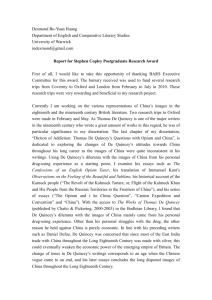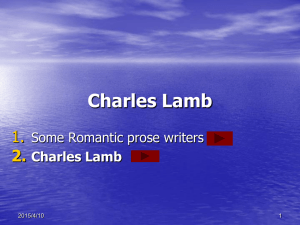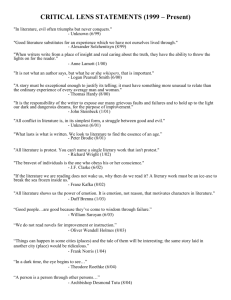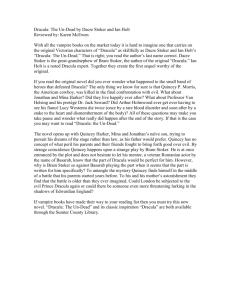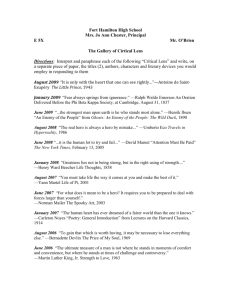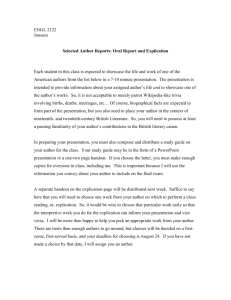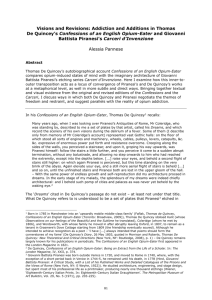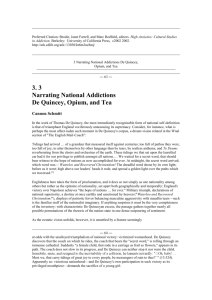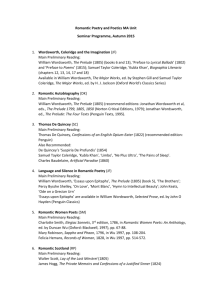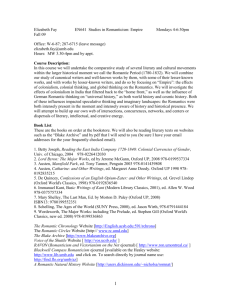Thomas De Quincey's Arabesque Confessions
advertisement
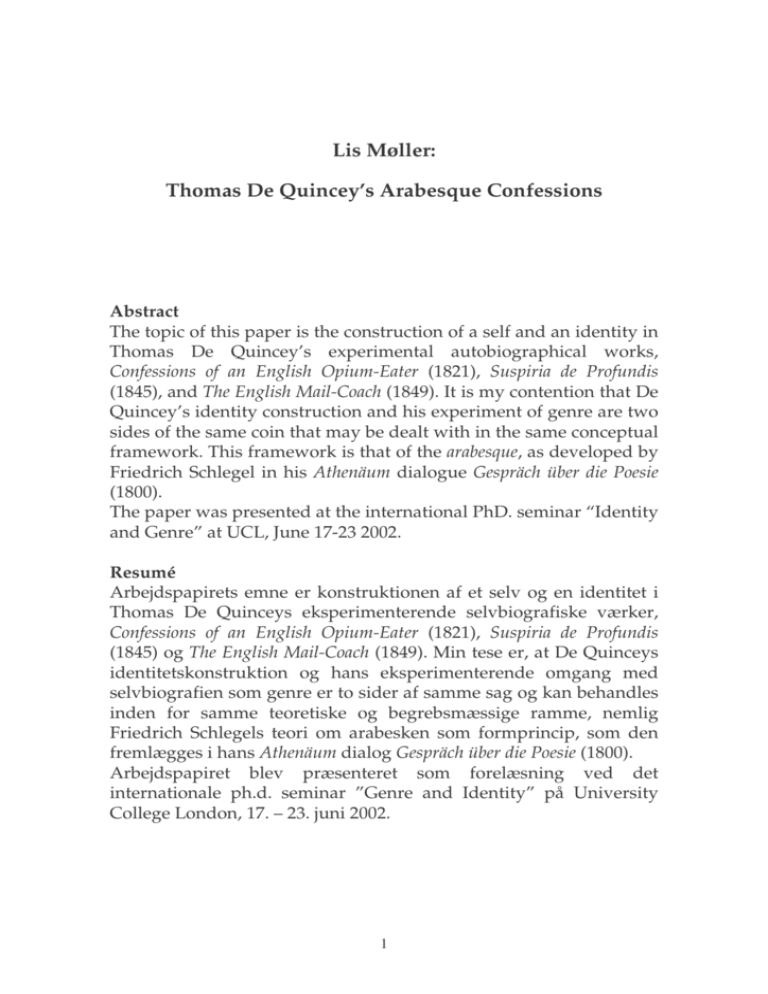
Lis Møller: Thomas De Quincey’s Arabesque Confessions Abstract The topic of this paper is the construction of a self and an identity in Thomas De Quincey’s experimental autobiographical works, Confessions of an English Opium-Eater (1821), Suspiria de Profundis (1845), and The English Mail-Coach (1849). It is my contention that De Quincey’s identity construction and his experiment of genre are two sides of the same coin that may be dealt with in the same conceptual framework. This framework is that of the arabesque, as developed by Friedrich Schlegel in his Athenäum dialogue Gespräch über die Poesie (1800). The paper was presented at the international PhD. seminar “Identity and Genre” at UCL, June 17-23 2002. Resumé Arbejdspapirets emne er konstruktionen af et selv og en identitet i Thomas De Quinceys eksperimenterende selvbiografiske værker, Confessions of an English Opium-Eater (1821), Suspiria de Profundis (1845) og The English Mail-Coach (1849). Min tese er, at De Quinceys identitetskonstruktion og hans eksperimenterende omgang med selvbiografien som genre er to sider af samme sag og kan behandles inden for samme teoretiske og begrebsmæssige ramme, nemlig Friedrich Schlegels teori om arabesken som formprincip, som den fremlægges i hans Athenäum dialog Gespräch über die Poesie (1800). Arbejdspapiret blev præsenteret som forelæsning ved det internationale ph.d. seminar ”Genre and Identity” på University College London, 17. – 23. juni 2002. 1 Identity, memory, and genre When Thomas De Quincey was a child of six, he lost his elder sister, Elizabeth, whom he dearly loved. The death of Elizabeth cast a gloomy shadow over his childhood. The boy was left with feelings of grief, pain, guilt and desolation for which he could find no expression. As the years went by, the memory of his sister grew fainter, and his sorrows were relieved. But the pains of childhood returned when as a young student at Oxford he began experimenting with opium, thus embarking upon what was to become a life-long addiction. In his opium dreams and hallucinations, the memory of Elizabeth rose again. The sight of her dead body, replayed in countless variations, was the dreadful vision which haunted his opium dreams. The story of the death of Elizabeth and her return as a recollected image, hallucination, and dream vision is narrated in Thomas De Quincey’s autobiographical work Suspiria de Profundis, published in 1845 as a sequel to his Confessions of an English OpiumEater which had first appeared in 1821. The dead sister is not mentioned in Confessions, but read in the light of Suspiria it seems obvious that the earlier work, too, is informed by the childhood trauma -- just as is The English Mail-Coach, published in 1849 as a 1 sequel to Suspiria. The dead body of Elizabeth is the theme around which De Quincey’s autobiographical writings melancholically revolve. At the same time his autobiographical project is a sustained 1 Thomas De Quincey (1785-1859) spent a lifetime writing and revising his autobiographical works. Confessions of an English Opium-Eater, which launched De Quincey as a writer, first appeared in the London Magazine in 1821. Confessions was to be continued, and almost 25 years later De Quincey published a sequel, Suspiria de Profundis, in Blackwood’s Magazine. Apparently De Quincey considered Suspiria to be a fragment of a magnum opus which were to include, among other things, The English Mail-Coach (first published in 1849 in Blackwood’s). The magnum opus was never completed. Instead, De Quincey transferred large parts of Suspiria to his Autobiographical Sketches (1853). He revised The English Mail-Coach (1854). And, finally, in 1856 he published a revised and much expanded edition of Confessions. Unless otherwise indicated, Confessions (C), Suspiria de Profundis (SP), and The English Mail-Coach (EMC) are quoted from the original versions, reprinted in: Confessions of an English-OpiumEater and Other Writings (ed. Grevel Lindop), Oxford, 1996. All other quotations are from The Collected Writings of Thomas De Quincey (ed. David Masson), London, 1896-97). 2 effort to ascribe a purpose and a meaning to the events of the past. In fact, the task that he undertakes is two-fold. On the one hand he seeks to faithfully represent and re-create an inner chaotic universe of wordless feelings, and of fragments of memory, phantasmagoria, and dream visions. On the other hand he strives to decipher the coded inscriptions of the childhood trauma -- that is, to interpret those events of childhood, the deeper meaning of which remained largely inaccessible to the child who lived through them. Ultimately, the pains of childhood and their persistent recurrence become the pivot of an insistent inquiry into the human mind: What constitutes the self? Is there in fact a unified self? What is personal identity? What is memory? And how does the subliminal mind revealed in dreams and hallucinations relate to the waking consciousness? Inquiring into the nature of the human self, Thomas De Quincey picks up the thread of the English empiricist philosophers, Locke and Hume, who drew the outlines of a modern, that is, a secular concept of the self and of personal identity. To Locke and Hume, the self is not given, but comes into being as the human mind deals with the impulses that it receives from the outside world. In his groundbreaking work, An Essay Concerning Human Understanding, which first appeared in 1690, Locke fiercely rejects the notion of ”innate ideas”. Certainly, the mind of man is from the outset endowed with certain mental faculties. But it has nothing to exercise these faculties upon until it opens itself to the influx of sense impressions. Sensations furnish the empty cabinet of the mind, says Locke. All ideas are ultimately derived from sensation, or rather, from the twin sources of sensation and reflection (that is, the mind perceiving its own mental operations). Ideas of sensation and reflection are the building blocks out of which all mental content is constructed. Pushing the empiricist philosophy of John Locke to sceptical extremes, David Hume, in his Treatise of Human Nature (1739-40), identifies his own self with the perceptions available to him at a given moment. No perceptions, no self. In the chapter entitled “Of Personal Identity”, he writes: For my part, when I enter most intimately into what I call myself, I always stumble on some particular perception or other, of heat or cold, light or shade, love or hatred, pain or pleasure. I never can catch myself at any time without a perception, and never can 3 observe anything but the perception. When my perceptions are removed for any time, as by sound sleep, so long am I insensible of myself, and may truly be said not to exist.2 I perceive, therefore I am. By emphasising sensation and perception, the empiricists overthrow an inherited metaphysics of the subject. But by the same token they call into question the very concept of the self. Hume is fully aware of this fact. Having equated the self with the mind’s perceptions, he proceeds to dismantle the notion of the unity of the self. The self, he writes, is nothing but a bundle or collection of different perceptions, which succeed each other with an inconceivable rapidity, and are in a perpetual flux and movement. Our eyes cannot turn in their sockets without varying our perceptions. Our thought is still more variable than our sight; and all our other senses and faculties contribute to this change; nor is there any single power of the soul, which remains unalterably the same, perhaps for one moment. The mind is a kind of theatre, where several perceptions successively make their appearance; pass, repass, glide away, and mingle in an infinite variety of postures and situations. There is properly no simplicity in it at one time, nor identity in different, whatever natural propension we may have to imagine that simplicity and identity. The comparison of the theatre must not mislead us. They are the successive perceptions only, that constitute the mind; nor have we the most distant notion of the place where these scenes are represented, or of the materials of which it is composed.3 It follows from Hume’s radical deconstruction that our conception of a unified self is nothing but an imaginary construction: a fiction. 4 A necessary fiction, perhaps, but nevertheless a fiction. In the context of empiricist philosophy, the word ‘identity’ means first of all ‘the state of remaining the same one’, over time, and under various conditions. According to Hume, personal identity, in this sense of the word, is a construction of the mind, based on its successive perceptions, which are in themselves distinct existences that show no actual identity. But even these 2 A Treatise of Human Nature Book I, Part IV, Sect. 6. Quoted from David Hume on Human Nature and the Understanding (ed. Antony Flew). London: Collier Macmillan, 1962, 259. 3 Hume, 259. 4 see Hume, 264. 4 successive perceptions would not be available to mind if it were not for the faculty of memory. In agreement with Locke, Hume stresses that the construction of a continuous self would not be possible without memory -- that is, the ability of the mind to retain and to store its ideas or perceptions and to revive these perceptions with 5 the “perception annexed to them, that it has had them before.” In remembering I revive past perceptions with the consciousness that I have had these perceptions before, or that it was I who have had these perceptions. By virtue of memory, consciousness extends itself beyond the present and ever fugitive moment. To the empiricist philosophers, then, personal identity is inextricably bound up with memory. Indeed, identity is an effect of memory. Thus Locke writes: “as far as this consciousness can be extended backwards to any past 6 action or thought, so far reaches the identity of that person.” And Hume: “As memory alone acquaints us with the continuance and extent of this succession of perceptions, it is to be considered, upon 7 that account chiefly, as the source of personal identity.” How does the self that emerges from Thomas De Quincey’s autobiographical works compare to the concepts of self th and identity of 18 -century empiricist philosophy? Following Locke and Hume, De Quincey largely identifies the self with memory. But memory, in the writings of Thomas De Quincey, far exceeds the conscious memory discussed in the works of Locke and Hume. Stimulated by opium, De Quincey’s waking memory as well as his nightly dreams, which form a mode of memory distinct from conscious memory, lead into recesses of the mind, undreamt-of in the philosophy of the empiricists. In Confessions of an English Opium Eater, De Quincey expounds the changes that took place in his dreams, as the addiction to opium grew stronger. Applying, incidentally, Hume’s metaphor of the mind, he writes: “a theatre seemed suddenly opened and lighted up within my brain, which presented nightly spectacles of more than earthly splendour” (C, 68). “I seemed every night to descend,” he continues, “not metaphorically, but literally to descend, into chasms and sunless abysses, depths below depths, 5 John Locke, An Essay Concerning Human Understanding Book II, Chapter X, 2. New York: Dover, 1959, Vol. 1, 194. 6 Locke, Book II, Chapter XXVII, 11. Vol. 1, 449. 7 Hume, 267. 5 from which it seemed hopeless that I could ever re-ascend” (C, 68). Descending into the abysses of the mind, the dreamer’s belief in the unity of the self is scattered. In a paragraph later omitted from The English Mail-Coach, De Quincey writes: The dreamer finds housed within himself – occupying, as it were, some separate chamber in his brain – holding, perhaps, from that station a secret and detestable commerce with his own heart -some horrid alien nature. What if it were his own nature repeated, – still, if the duality were distinctly perceptible, even that – even this mere numerical double of his own consciousness – might be a curse too mighty to be sustained. But how, if the alien nature contradicts his own, fights with it, perplexes and confounds it? How, again, if not one alien nature, but two, but three, but four, but five, are introduced within what once he thought the inviolable sanctuary of himself? (EMC, 201) But while suggesting to the dreamer the possibility a multiplicity of conflicting selves, the opium dreams also disclose relations and correspondences otherwise unsuspected. Not only do the dreams convince him of the fact that seemingly long-forgotten incidences of early childhood are retained in his unconscious memory and may once again be brought to light; in dreaming he becomes aware of connexions between experiences, thoughts, or feelings, which, to the waking mind, appeared to be wholly discontinuous and independent. Thus the dream – writes De Quincey – points to the fact that “the nearer and more distant stages of life [are] dimly connected.” But the relations are “hidden” and only revealed to the conscious mind in glimpses. Thus while the dream world of the opium eater spells darkness and anarchy, it also indicates the existence of an order or an ordering principle, which, however, remains largely inaccessible to the waking consciousness. Ultimately, the dream, according to De Quincey, opens onto a transcendent realm, beyond individual subjectivity. In a remarkable passage from the Introduction to Suspiria de Profundis, De Quincey – combining the image of the camera obscura (which, in empiricist philosophy, is a favourite metaphor of the mind) with the Platonic metaphor of the cave – expounds the power of dreaming: 6 The machinery for dreaming planted in the human brain was not planted for nothing. That faculty, in alliance with the mystery of darkness, is the one great tube through which man communicates with the shadowy. And the dreaming organ, in connexion with the heart, the eye, and the ear, compose the magnificent apparatus which forces the infinite into the chambers of a human brain, and throws dark reflections from eternities below all life upon the mirrors of the sleeping mind. (SP, 88) The power of dreaming reveals the potential grandeur and sublimity of the human mind as it merges into the infinite. But, merging into the infinite, the contours of the self dissolve. Beyond a certain point, all inquiries into the self, individuality, or personal identity of man become meaningless. De Quincey’s construction of a self and an identity and his genre experiments are two sides of the same coin. The autobiographical project of Thomas De Quincey cannot be realized within the framework of any known genre, least of all that of a conventional autobiographical narrative. The title of De Quincey’s first autobiographical work may suggest an affinity with Rousseau’s Confessions, but neither Confessions of an English Opium-Eater nor its sequels, Suspiria de Profundis and The English Mail-Coach, have, in fact, much in common with the chronologically progressive and fairly straightforward narrative of Rousseau’s autobiography. All three are bold experiments in genre, exploring new modes of expression. In fact, De Quincey aspires to invent a wholly new form of autobiographical narrative – a form that mimics the symbolical language of the dream, yet retains a high degree of self-reflectivity. It is the contention of this paper that De Quincey’s identity construction and his genre experiments may be dealt with in the same conceptual framework, namely that of the arabesque. In the following, I propose to pursue this line of argument. The arabesque Thomas De Quincey himself never referred to his autobiographical writings as arabesques. The arabesque qualities of his prose were, however, noted by Charles Baudelaire, himself a poet of the arabesque, who in 1860 published an annotated translation of selected passages from Confessions and Suspiria under the title Les paradis artificiels. Here Baudelaire presents the work of De Quincey 7 as a “tapisserie fantastique”. De Quincey’s prose is “essentiellement digressif”, writes Baudelaire, and he proceeds: “la pensée de De Quincey n’est pas seulement sineuse; le mot n’est pas assez fort; elle 8 est naturellement spirale.” This last observation is prompted by De Quincey’s “Introductory Notice” to Suspiria. In this preface, which looks back to Confessions as well as forwards to the work it introduces, De Quincey states that “the whole course of this narrative resembles, and was meant to resemble, a caduceus [herald’s staff] wreathered about with meandering ornaments, or the shaft of a tree’s stem hung round and surmounted with some vagrant parasitical plant.” The theme of opium abuse, he goes on to explain, should be regarded as the staff whose only function is to support the dream visions, fantasies, and recollections twining around it: The mere medical subject of the opium answers to the dry withered pole, which shoots all the rings of the flowering plants, and seems to do so by a dexterity of its own; whereas, in fact, the plant and its tendrils have curled round the sullen cylinder by mere luxuriance of theirs. (…) Upon the same analogy, view me, as one (in the words of a true and most impassioned poet) ‘viridantem floribus hastas’ – making verdant, and gay with the life of flowers, murderous spears and halberts – things that express death in their origin, (being made from dead substances that once had lived in forests,) things that express ruin in their use. The true object in my “Opium Confessions” is not the naked physiological theme – on the contrary, that is the ugly pole, the murderous spear, the halbert – but those wandering musical variations upon the theme -- those parasitical thoughts, feelings, digressions, which climb up with bells and blossoms round about the arid stock; ramble away from it at times with perhaps too rank a luxuriance (…). (SP, 94) The sinuous and meandering leafy stem, stylised into unreal and fantastical forms, is, of course, the ground figure of the ornamental arabesque. As is well known, the arabesque originates in the decorative arts of the Arabic world. And, in accordance with Islamic thinking, art should depart from natural phenomena. The arabesque, then, is essentially a non-mimetic form. The stem bifurcates and winds itself along in regular waves, in spirals, or in a complicated interlacing. The leaves slit open or fuse into pointed 8 Charles Baudelaire, Les paradis artificiels. Paris, 1972. 124 and 229. 8 ovals. Order in variety – achieved through rhythmic variations and alternations, mirror repetitions and duplications – remains the fundamental aesthetic principle of the ornamental arabesque. Essential to the arabesque are also its uninterrupted and ever9 continuing course and the “principle of complete coverage.” No element appears in isolation, and there are no empty spaces in the composition. As indicated by the paragraph quoted above, the characteristics of the ornamental arabesque do indeed apply to the prose style of Thomas De Quincey. The narrative line is not merely sinuous; like the arabesque it grows through bifurcations and side shoots – digressions, associations, insertions, parentheses, footnotes, and even footnotes to footnotes. His works may, at first, give the impression of being utterly chaotic. But, as Coleridge observed, the mind of Thomas De Quincey is “systematic” as well as “labyrinthine”. His associations and digressions do not merely wander off in different directions, but interlace into a complicated pattern. Repetition and displacement – the reappearance with variations of themes and motifs – are characteristic features of the autobiographical works. Thus Confessions, Suspiria and The English Mail Coach create a vast and ever expanding network of internal connections, references, and allusions. Finally, De Quincey’s prose is highly ornamented. The wordy profusion, the accumulation of metaphors and images seem – like the arabesque – to originate in a veritable horror vacui. The following specimen of De Quincey’s hyper-aesthetical prose is chosen almost at random from Suspiria de Profundis: Fancy not, reader, that this tumult of images, illustrative or allusive, moves under any impulse or purpose of mirth. It is but the coruscation of a restless understanding, often made ten times more so by the irritation of the nerves, such as you will first learn to comprehend (its how and its why) some stage or two ahead. The image (…) is but too repellent of laughter; or, even if laughter had been possible, it would have been such laughter as oftentimes is thrown off from the fields of ocean -- laughter that hides, or that seems to evade mustering tumult; foam-bells that weave garlands of phosphoric radiance for one moment round the eddies of gleaming abysses; mimicries of earth-born flowers that for the eye 9 Ernst Kühnel, The Arabesque. Meaning and Transformation of an Ornament (trans. Richard Ettinghausen). Graz: Verlag für Sammler, 1976, 8. 9 raise phantoms of gaiety, as oftentimes for the ear they raise echoes of fugitive laughter, mixing with the ravings and choir-voices of an angry sea. (SP, 143-44) In applying the concept of the arabesque to the written work of art, I follow in the footsteps of Friedrich Schlegel who, in his essay “Brief über den Roman”, uses the arabesque as the aesthetical concept on which he bases his theory of the novel. In this essay, which forms part of the Athenäum dialogue Gespräch über die Poesie (1800), Schlegel stands up for the novels of Friedrich Richter (Jean Paul), Diderot, and Sterne, which have been dismissed by the critics as 10 “ein buntes Allerley von kränklichem Witz.” The mixture of the witty and the absurd, the sentimental and the fantastical in a novel such as Jacques le fataliste may not qualify this work as great literature, says Schlegel; it is only an arabesque, “nur eine – Arabeske.” But, he continues, “eben darum hat es in meinen Augen keine geringen Ansprüche; denn ich halte die Arabeske für eine ganz bestimmte und wesentliche Form oder Äusserungsart der 11 Poesie.“ The arabesques, he adds, are “die einzigen romantischen 12 Naturprodukte unseres Zeitalters.“ Although “Brief über den Roman” does not explicitly refer to Tristam Shandy (1759-67), Schlegel most certainly had this novel in his mind as he developed his concept of the arabesque. In this highly digressive and associative novel, Sterne, or rather his narrator, self-consciously displays his inability to make his narrative conform to the rules of Aristotelian poetics. Reflecting upon the story that he is telling, the narrator inserts a series of graphs, visualizing the narrative course of his story in the form of the sinuous and meandering line of the arabesque. Sterne’s self-conscious and self-reflective novel points towards the idea of the novel as ‘a romantic book’ expounded in Schlegel’s essay. The purpose of “Brief über den Roman” is not simply to defend the mixture of styles and genres in the works of th late 18 -century novelists such as Jean Paul, but to appropriate the 10 Friedrich Schlegel, Gespräch über die Poesie. Athenäum. Eine Zeitschrift von August Wilhelm Schlegel und Friedrich Schlegel. Berlin, 1800 (Fotomech. Nachdr. 1960), 113. 11 Schlegel 1800, 116. 12 Schlegel 1800, 126. 10 concept of the arabesque for a vision of the romantic novel. This novel, which has not as yet been written, should bring together all genres and combine Dante, Cervantes, and Shakespeare into a new, hybrid and dialogical “Universalpoesie”. Furthermore, it should combine the novel with the theory of the novel. “Eine solche Theorie des Romans,” writes Schlegel, würde selbst ein Roman sein müssen, der jeden ewigen Ton der Phantasie phantastisch wiedergäbe, und das Chaos der Ritterwelt noch einmal verwirrte. Da würden die alten Wesen in neuen Gestalten leben; da würde der heiligen Schatten des Dante sich aus seiner Unterwelt erheben, Laura himmlisch vor uns wandeln, und Shakespeare mit Cervantes trauliche Gespräche wechseln; - und da würde Sancho von neuem mit dem Don Quixote scherzen. 13 Das wären wahre Arabesken (...). In his comprehensive study of the arabesque in Friedrich Schlegel’s aesthetics, Karl Konrad Polheim distinguishes different levels in the 14 romantic concept of the arabesque. In Schlegel, Polheim points out, the arabesque marks a preliminary stage of the ideal form as well as the ideal form itself. In this capacity, the arabesque becomes a key term in romantic aesthetics, which sees itself as the Organon of a philosophy aiming at the absolute, as well as in the ‘new mythology’ envisioned by Schlegel. On this point Schlegel definitely departs from Sterne, whose witty and playful novel certainly does not pretend to reach out to the infinite. Why is it that the arabesque becomes essential to the romantic quest? For one thing, the ever-continuing course of the ornamental arabesque makes it an open-ended form, in contrast to the finished and self-enclosed form celebrated in classical aesthetics. The arabesque reaches beyond itself, towards a vanishing point. It is, in Schlegels’s terminology, ‘progressive’, that is, it is an infinite approximation, forever in a state of becoming. His definition, in the well-known Athenäum fragment no. 116, of romantic poetry as a “progressive, universal poetry” immediately applies to the arabesque. Romantic poetry, he writes in this fragment, hovers “on the wings of poetic reflection” and raises “that reflection again and again to a higher power” as it multiplies it “in an endless succession 13 14 Schlegel 1800, 125-26. Karl Konrad Polheim, 11 15 of mirrors.” Furthermore, the arabesque balances or reconciles opposite and discordant qualities. It is at once nature and artifice, chaos and system. The arabesque, says Schlegel, is the oldest and most original form of the human imagination. It is an ‘artfully organized confusion’, a ‘charming symmetry of contradictions’, a ‘wonderful perennial alternation of enthusiasm and irony’. These last statements are taken from “Rede über die Mythologie“, in which Schlegel associates the arabesque with the alternations and metamorphoses that constitute the method of the new mythology, ‘the most artful of all works of art’. In the weaving of mythology, he writes, “ist das Höchste wirklich gebildet; alles ist Beziehung und Verwandlung, angebildet und umgebildet, und dieses Anbilden und Umbilden eben ihr eigentümliches Verfahren, ihr innres Leben, 16 ihre Methode.“ The arabesque, then, is basically a dynamic form. Its essence is motion and metamorphosis. Arabesque and identity I have dealt at some length with Friedrich Schlegel’s theory of the arabesque because I consider this theory to be of importance to Thomas De Quincey’s autobiographical writings. In characterizing these writings as arabesques, I do not merely refer to his meandering digressions or to his highly ornamented, hyperaesthetical prose, although these features are indeed essential to his enterprise. Following Schlegel, I take the arabesque to be a form or rather a formative principle. It is this formative principle that governs De Quincey’s autobiographical construction of a self and an identity. In Suspiria de Profundis and later in his Autobiographical Sketches, Thomas De Quincey makes the following observation on man’s paradoxical oneness and lack of oneness. “Man,” he writes, is doubtless one by some subtle nexus, some system of links, that we cannot perceive, extending from the new-born infant to the superannuated dotard: but, as regards many affections and passions incident to his nature at different stages, he is not one, but 15 Friedrich Schlegel, Fragmente. Athenäum. Eine Zeitschrift von August Wilhelm Schlegel und Friedrich Schlegel. Berlin, 1798 (Fotomech. Nachdr. 1960), 205. Quoted from the English translation Peter Firchow in: Philosophical Fragments. Minneapolis. University of Minnesota Press, 1991, 32. 16 Schlegel 1800, 102. 12 an intermitting creature, ending and beginning anew; the unity of man, in this respect, is co-extensive only with the particular stage to which the passion belongs. (Masson I, 43). Following Hume, De Quincey represents identity, not as an essence or a substance, a core or changeless centre, which remains untouched by the contingencies of life, but as a system of relations. “Identity,” writes Hume, “depends on the relation of ideas; and 17 these relations produce identity.” In emphasizing the relations between ideas rather than the particular idea (or event, thought, action, or feeling) in itself, both Hume and De Quincey maintain a structural conception of identity. But while the relations that produce identity, according to Hume, first of all are the relations of cause and effect supplied by the mind itself, the subtle system of links which De Quincey is referring to is of a more comprehensive and complex nature. In the revised edition of Confessions he allegorises the life of man as a journey through a vast and labyrinthine forest: In fact, every intricate and untried path in life, where it was from the first a matter of arbitrary choice to enter upon it or avoid it, is effectually a path through a vast Hercynian forest, unexplored and unmapped, where each several turn in your advance leaves you open to new anticipations of what is next to be expected, and consequently open to altered valuations of all that has already been traversed. Even the character of your own absolute experience, past and gone, which (if anything in the world) you must surely answer for as sealed and settled for ever – even this you must submit to hold in suspense, as a thing conditional and contingent upon what is yet to come – liable to have its provisional character affirmed or reversed, according to new combinations into which it may enter with elements only yet perhaps in the earliest stages of development. (Masson III, 314-15) The system of links, then, is always in the making. It is modified by each new addition. No single element in this structure, therefore, retains a stable or fixed position; it is always liable to enter into new combinations and, consequently acquire a different meaning and significance. No experience is simply an event of the past. The past 17 Hume, 267. 13 is effective in the present; but present experience, too, works on the past. In De Quincey, causality works backwards, as it were, as well as forwards. Given this structural conception of identity, one should not be surprised that De Quincey rejects the chronologically progressive narrative as mode of representation. His reasons for rejecting the chronological account are worth paying attention to. In Autobiographical Sketches he writes: The reader who may have accompanied me in these wandering memorials of my own life and casual experiences, will be aware that in many cases the neglect of chronological order is not merely permitted, but in some degree inevitable. There are cases, for instance, which, as a whole, connect themselves with my own life at so many different areas that, upon any chronological principle of position, it would have been difficult to assign them a proper place; backwards or forwards they must have leaped, in whatever place they had been introduced; and in their entire compass, from first to last, never could have been presented as properly belonging to any one present time, whensoever that had been selected: belonging to every place alike, they would belong, to the proverb, to no place at all; or (reversing the proverb), belonging to no place by preferable right, they would, in fact, belong to every place. (Masson I, 287) Not only does De Quincey dismiss chronology as the organizing principle of his autobiography; what he is saying is, in fact, that the crucial events of life – the events that form the subject matter of Confessions, Suspiria and The English Mail-Coach – cannot be dealt with within the framework of a successive account. Only an atemporal and non-successive form may do justice to these events that are present everywhere and at all times. Such a form is, in fact, what De Quincey seems to be aiming at in his three experimental autobiographical works. The impossibility of the task that he has undertaken must indeed have been obvious to De Quincey who, in 1826-27, published an annotated translation of Lessing’s Laokoon: oder über die Grenzen der Malerei und Poesie which originally appeared in 1866. As is well known, in this study, Lessing makes a clear distinction between, on the one hand, the sign language of the visual and plastic arts, and, on the other hand, the sign language of poetry. While the language of visual art, according to Lessing, is composed of visual signs co- 14 existing in space, the language of poetry and literature consists of acoustic signs succeeding each other in time. While the signs of the visual arts exist nebeneinander, the signs of literature follow nacheinander. Applying the conceptual language of Lessing’s study, the task that De Quincey has undertaken may be described as the representation of ideas existing simultaneously in the mind by means of a language consisting of consecutive signs. He must seek to convert the linearity and successiveness, the nacheienander, of the linguistic signifier into the simultaneity, the nebeneinander, of the visual sign. Simultaneity in writing is, of course, an ideal that can never be fulfilled. It can only be approximated. The autobiography that De Quincey is writing is not an account of his own life, but a topography of the mind. Dreams, hallucinations, fantasies, and visions are as important as actual events and are dealt with on an equal footing. Boldly setting aside chronology, De Quincey spins a finely meshed web of analogies and correspondences. Incidents belonging to different stages of his life are joined together in relations of similarity or contrast. Indeed, the densely metaphorical style of De Quincey’s autobiographies may be said to imitate the hyper-condensed language of the dream, which – according to the German romantic dream theorist Gotthilf Heinrich von Schubert – is a hieroglyphic language far more spiritual and expressive than the discursive language of the waking mind. The single most important event of De Quincey’s autobiography is the death of his sister Elizabeth. But to which part of his story does this tragic event belong? To the child who had the experience, but who didn’t understand, and who eventually forgot? To the youth who, in his opium dreams, relived and remoulded the pains of childhood? Or to the adult who, in writing his autobiography, strives to interpret? As De Quincey makes it clear, it belongs to, and must be represented as belonging to, all of these at once. There is literally not one single page of De Quincey’s autobiography that does not somehow bring to mind the death of Elizabeth. Her dead body is virtually omnipresent. The death of Elizabeth is the point in which all lines of association intersect. Everything else in De Quincey’s autobiographical writings seems to emanate from this event, or, conversely, to fuse into it. 15 On the level of narrated events, the death of Elizabeth repeats itself in a number of different experiences from childhood, youth, and manhood, all which pertain to the death of or the separation from a female figure. Just to mention some of the most important: (1) The boy’s separation from Ann, the young prostitute who saved his life in London. (The story of the loss of Ann is told in Confessions). (2) The death of Jane, a younger sister, previous to the death of Elizabeth (Suspiria). (3) The near-death of an unknown young woman, who was hit by a mail coach on which De Quincey was a passenger (English Mail-Coach). (4) The childhood memory of the death of two twin sisters (Autobiographical Sketches). Even the romantic memory of kissing Fanny, the coachman’s granddaughter, somehow connects itself with the death of Elizabeth. In parting from his sister’s body, the child pressed a kiss on her forehead. Not only do all these memories refer to the loss of Elizabeth; they are themselves reciprocally connected through similarity and contrast. Indeed, in the vast web of Thomas de Quincey’s autobiographies, everything seems somehow to be connected with everything else. Consequently, the reader’s unravelling of the network may start anywhere. In this respect, De Quincey’s autobiography does indeed approximate the simultaneity of a spatial construct. To De Quincey, however, identity is not just a system of links; it is a system in process – a system in motion. Of all the creatures, real and imaginary, haunting De Quincey’s opium dreams, no one inspires greater terror in him than the crocodile. The crocodile is an object of horror, because (in his own words) it does not change. It seems exempt from the process of evolution to which everything living is subject. In fact, De Quincey shows an aversion towards everything suggesting immobility, stasis, and stagnation. One easily sees why: If nothing really changes, he will never escape from the pains of childhood and Elizabeth’s death will forever remain unjustified. The task that confronts the autobiographer, then, is twofold. On the one hand, he must convert a chronological succession of events into a simultaneous structure, and he must invent a mode of representation capable of expressing this simultaneity. On the other hand, the entire system must be set in motion. The vast network of analogies and correspondences must be conceived of in terms of a dynamic structure of reciprocal action and re-action, in which everything is still in the making, directed 16 towards a future completion. The arabesque, I think, is the only form that may reconcile these seemingly contradictory demands. It is essential to the arabesque that no element should appear in isolation. According to Schlegel, however, the arabesque is not just “Beziehung”, connexion; it is “Beziehung und Verwandlung”, connexion and metamorphosis. Its vital principle is the perpetual alternation between expansion and contraction. The arabesque folds back upon itself only to transgress itself. In De Quincey, the repetitions, as well as the endless digressions and the accumulations of images and analogies, check the narrative progression. The narrative line coils; it folds back upon itself. But repetition, in De Quincey’s autobiographies, is also a subtle mode of transformation. In Suspiria de Profundis, the account of ‘the afflictions of childhood’, that is, of the loss of Elizabeth, is followed by four smaller pieces, each reflecting upon this loss, but displacing it into the language of allegory. In the context of Suspiria, allegorising is a redemptive as well as a repetitive strategy. Each of the four allegorical pieces is a Janus-faced construction, one face looking back on the pains of childhood, the other directed towards a possible future justification. Or: one face looking into the depths of the child’s sufferings, the other directed towards the starry sky above. As De Quincey makes it clear, he meant his text to form an ascending movement. Concluding his story of the pains of childhood, he breaks off the autobiographical account and addresses the reader: Here pause, reader! Imagine yourself seated in some cloud-scaling swing, oscillating under the impulse of lunatic hands, for the strength of lunacy may belong to human dreams (…). Seated in such a swing, fast as you reach the lowest point of depression, may you rely on racing up to a starry altitude or corresponding ascent. Ups and downs you will see, heights and depths, in our fiery course together, such as will sometimes tempt you to look shyly and suspiciously at me, your guide, and the ruler of the oscillations. Here, at the point where I have called a halt, the reader has reached the lowest depth in my nursery afflictions. From that point, according to the principles of art which govern the movement of these Confessions, I had meant to launch him upwards through the whole arch of ascending visions which seemed requisite to balance the sweep downwards, so recently described in his course. (SP, 137) 17 The function of the allegorical pieces, then, is to facilitate the transition from the lowest depths to the starry altitude. As indicated by De Quincey’s metaphor of the swing, however, the ascending movement must be endlessly repeated. The structural logic of Suspiria is that of the pendulous movement. In Suspiria de Profundis, the death of Elizabeth is refracted, like light in a prism, into four separate allegories. In The English Mail Coach De Quincey adopts a somewhat different strategy. The terrible sight of the mortal dread of an unknown woman (a substitute, of course, for Elizabeth) as she looks death in the face is replayed in the form of a fantasy, which De Quincey, significantly, entitles “Dream Fugue”. To De Quincey, the musical fugue is an alternation, a Wechsel, comparable with that of the arabesque: “approaching, receding, - attracting, repelling, - blending, separating, - chasing, chased” (Masson X, 97). The “Dream Fugue” is composed of four scenes or movements. The first three are variations on the following scenario: The dreamer beholds a young woman in imminent danger, but is incapable of coming to her rescue. In each of these scenes she perishes before his eyes; she is engulfed by the waves of a raging ocean or she sinks into quicksand. The fourth and final scene is different. The mail coach on which De Quincey, in the original experience, was a passenger has been transformed into a war chariot. This chariot races down the aisle of a grand cathedral which, in turn, metamorphoses into a vast necropolis, mausoleums rising on each side. Suddenly the dreamer sees in front of the car a female figure -- not the woman, but a little girl. Collision seems inevitable. But, all of a sudden, at the signal of a trumpet, the chariot with men and horses and all freezes into a stone sculpture. At a second signal it comes to life again. But the girl, who has metamorphosed into a woman, has been transferred to the altar of the cathedral, an angel kneeling at her side. The dream fugue breaks off just before the expected redemption of the woman. The fantasy ends – but only to be repeated “a thousand times” (EMC, 233). It is the nature of the arabesque that it should forever be becoming; fulfilment or completion is always just beyond reach. Total recall The Christian imagery of De Quincey’s autobiography might suggest that the fulfilment to which he is aspiring is a completion in 18 the hereafter. This, however, is not the case. Redemption, in De Quincey, is of a worldly nature; it is his firm belief that he shall “rise again before he dies” (SP, 153). And yet this fulfilment is an experience that must forever remain beyond the reach of the genre of autobiography. Indeed, it is the one personal experience that can never be told by an autobiographical narrator. For completion, in De Quincey, is the moment of dying; the moment just before death sets in. It is hardly surprising that De Quincey should look forward to death as the event that will impose a final meaning. In life, the final meaning, according to De Quincey, is always deferred: “Even the character of your own absolute experience, past and gone,” he wrote in Confessions, “even this you must submit to hold in suspense, as a thing conditional and contingent upon what is yet to come – liable to have its provisional character affirmed or reversed, according to new combinations into which it may enter with elements only yet perhaps in the earliest stages of development.” According to De Quincey, however, death does not only impose an ending. The moment of dying is envisioned as a moment of total recall. To De Quincey, the recurrence in his opium dreams of long-forgotten incidents, which remain inaccessible to the waking mind, lends credibility to the belief emerging from his autobiographical writing, namely that “there is no such thing as forgetting possible to the mind” (C, 69). Every single impression, every action, and every thought, even the most casual and insignificant, is retained in memory. Nothing that has entered the human brain will ever perish; everything is still there. Only this vast store of memories is not available to the conscious mind. A “veil” has been imposed, says De Quincey, “between our present consciousness and the secret inscriptions on the mind” (C, 69). The moment of death, then, is the moment of unveiling; the curtain is lifted and everything is exposed. One would naturally expect this experience of total recall to be an experience of overwhelming chaos. But according to De Quincey, this will not be the case: The fleeting accidents of a man’s life, and its external shows, may indeed be irrelate and incongruous; but the organizing principles which fuse into harmony, and gather about fixed predetermined centres, whatever heterogeneous elements life may have 19 accumulated from without, will not permit the grandeur of human unity greatly to be violated (…). (SP, 144) The moment of death finally establishes the oneness of man. I have said that the moment of dying is the one experience that you will not live to tell. But a few do in fact return from the borderland of death. Among them was De Quincey’s own mother. As a child she fell into a river and was only rescued at the very last moment. The family anecdote of her experience at the threshold of death plays a crucial part in De Quincey’s anticipation of the final vision. Not only does his mother’s experience substantiate his belief in a total recall; the family anecdote reveals to him the form of this totalising vision: “she saw in a moment her whole life, in its minutest incidents, arrayed before her simultaneously as in a mirror; and she had a faculty developed as suddenly for comprehending the whole and every part” (C, 69). At the moment of dying, the sum total of one’s past experiences return, not as a succession, nacheinander, but as parts of a co-existence, nebeneinander. In the final vision, myriads of successive impressions and ideas are remoulded into a simultaneity. Not the approximate co-existence of the arabesque, but an actual and literal simultaneity. (…) a mighty theatre expanded within her brain. In a moment, in the twinkling of an eye, every act -- every design of her past life lived again -- arraying themselves not as a succession, but as parts of a coexistence. (…) A pall, deep as oblivion, had been thrown by life over every trace of these experiences; and yet suddenly, at a silent command, at the signal of a blazing rocket sent up from the brain, the pall draws up, and the whole depths of the theatre are exposed. (SP, 145) In this last passage, De Quincey revives Hume’s metaphor of the mind, but the meaning of this metaphor has been reversed. In Hume, the theatre is an image of the perpetual flux and movement of the mind’s successive perceptions and, consequently, of the absence of any actual unity or identity. In De Quincey, the metaphor of theatre connotes the simultaneous visibility and comprehensibility of the mind’s perceptions. The theatre is an image 20 of the inexpressible: the anticipated revelation of an identity that has finally been completed. 21 CV Lis Møller (born 1955) is Associate Professor of Comparative Literature at the University of Aarhus. Her publications within the field of Romanticism includes articles on Wordsworth and Coleridge. She is co-editor (together with Marie-Louise Svane) of Romanticism in Theory. Aarhus: Aarhus University Press, 2001. She is currently working on a book on Romantic memory. 22
